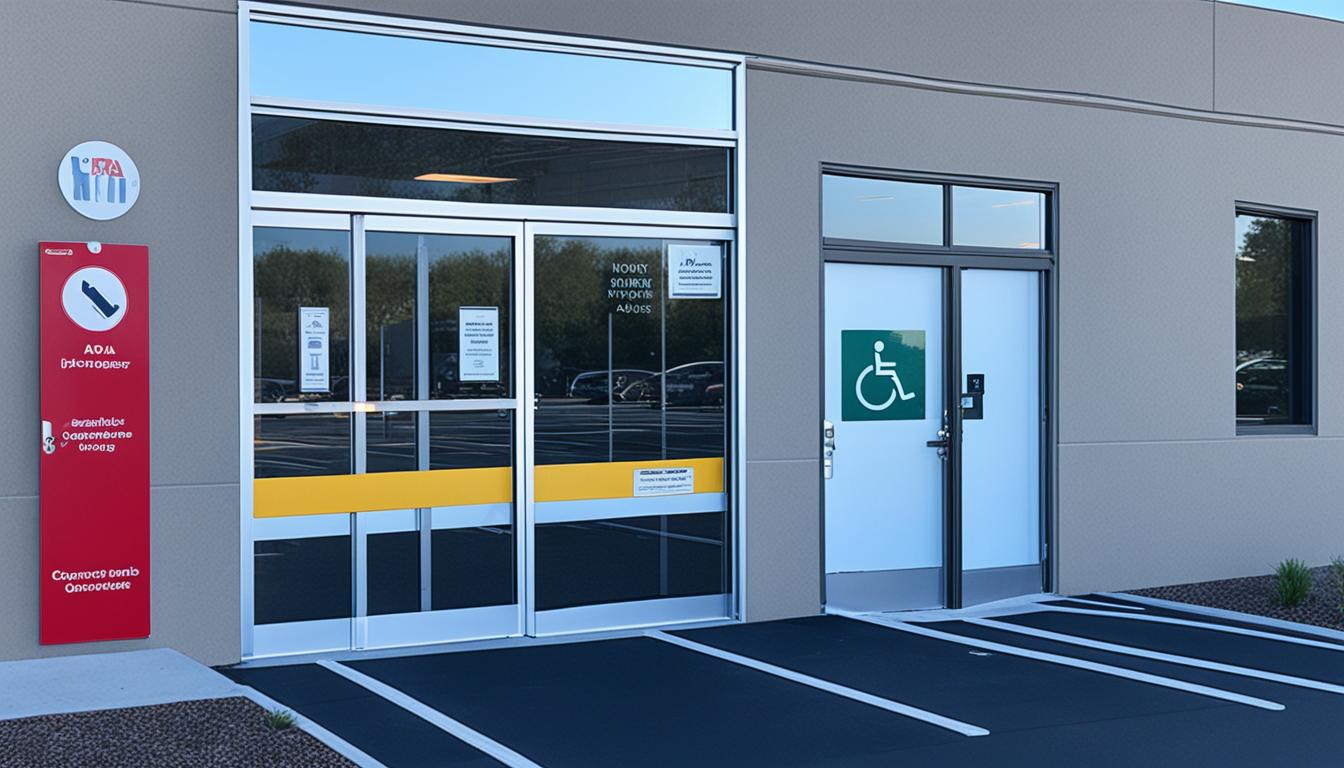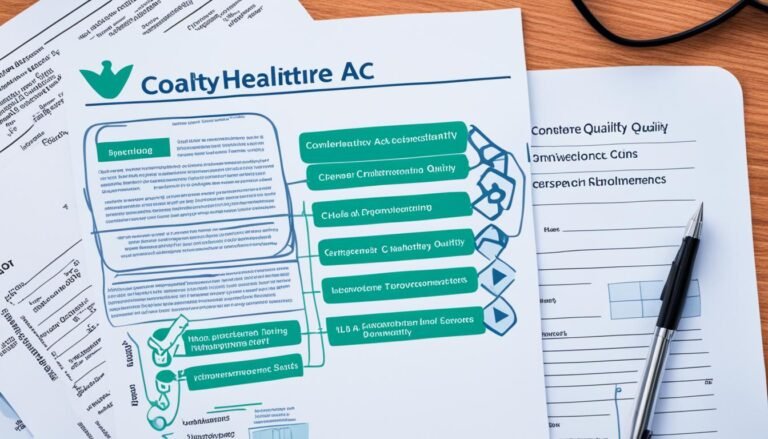Understanding the Americans with Disabilities Act
Each year, about 2.5 million Americans face new disabilities. This fact shows the crucial need for understanding the Americans with Disabilities Act (ADA). Since 1990, the ADA has been a vital law. It works to ensure equal rights and better access for those with disabilities. It aims to remove barriers not just in buildings but also in jobs, government services, and places open to the public. Learning about ADA compliance, regulations, and what it requires is important. It’s more than just following the law; it’s about building a community that welcomes everyone equally.
Key Takeaways
- The ADA exemplifies a transformative stride towards equality for individuals with disabilities.
- Understanding ADA compliance is vital for both legal adherence and social inclusion.
- ADA regulations touch various facets of life, emphasizing the law’s extensive impact.
- Organizations must adhere to ADA requirements to provide equal access and opportunities.
- ADA’s relevance continues to grow with the increasing number of Americans with disabilities.
What is the Americans with Disabilities Act (ADA)?
The ADA definition outlines it as a major civil rights law from 1990. It aims to stop discrimination against people with disabilities. This law makes it easier for them to be part of everyday life in the U.S. It covers jobs, government services, public places, transport, and more.
The ADA overview shows its vision for a society where everyone, including those with disabilities, plays a part. It requires work and public places to be disability-friendly. This is to support full participation for all. The ADA protects both physical and mental disabilities, showing its broad scope.
Enforcing the ADA is key to its success. Agencies like the EEOC and the Department of Justice watch over this. They make sure everyone follows the rules, so barriers for disabled people are removed.
“The ADA is a clear and comprehensive national mandate for the elimination of discrimination against individuals with disabilities.” – ADA Preamble
This law is more than rules; it’s about building a world that values everyone. Due to the ADA, there’s more access and opportunity for people with disabilities. It shows a strong commitment to making society equal for everyone.
The Purpose and Vision Behind the ADA
The Americans with Disabilities Act (ADA) is a key civil rights law. It aims to end exclusion for those with disabilities. The ADA brings disability rights into everyday life. It makes society more inclusive and sparks big changes.
It shows a commitment to equal rights and chances for everyone to succeed. The ADA vision includes seeing disability as part of human diversity. It pushes for understanding and acceptance.
It dreams of a world without physical or social barriers. A place where the needs of disabled people are met. This ensures they can join in all areas of life fully.
The ADA doesn’t just want to include those with disabilities. It fights for their right to be included—showing that disability doesn’t limit one’s value or abilities.
- Removing physical blocks improves ADA accessibility.
- Changing rules and practices upholds ADA purpose.
- Providing aids and services makes communication better.
- Making sure new technology is accessible for all.
Looking ahead, the ADA guides us towards a diverse and welcoming future. It’s not just about access. It’s about seeing everyone’s strength and potential.
The ADA vision helps everyone understand and support disability rights. It is key in creating a world that’s accessible to everyone.
Key Provisions of the ADA
The Americans with Disabilities Act (ADA) includes key steps to make society more inclusive. It has ADA provisions split into ADA titles. Each one focuses on improving different areas of public life. We will explore what these provisions mean and the ADA requirements for employers, governments, and businesses.
Employment Opportunities and Protections (Title I)
Title I of the ADA helps protect jobs for people with disabilities. It says that if a place has 15 or more workers, it can’t discriminate based on disability. This section makes sure people with disabilities get a fair chance at jobs, promotions, and benefits. Employers must also make reasonable changes to help their employees with disabilities, as long as it’s not too hard on the business.
State and Local Government Services (Title II)
Title II makes sure state and local governments consider everyone. It covers many services, like schools and buses, to ensure no one is left out or treated unfairly. They might need to change rules or the way they communicate. The goal is simple: everyone should get to use these services without trouble.
Public Accommodations and Services by Private Entities (Title III)
Title III looks at what private businesses that serve the public need to do. They can’t discriminate and must be accessible to everyone. This includes places like stores, movie theaters, and taxis. They must meet certain standards and offer help, like different ways of communicating, so everyone can enjoy their services.
| ADA Title | Applicability | Core Requirements |
|---|---|---|
| Title I – Employment | Employers with 15+ employees | Non-discrimination in employment; Reasonable accommodations |
| Title II – Public Services | State and local governments | Accessibility and modifications in all government programs and services |
| Title III – Public Accommodations | Private entities serving the public | Accessibility standards for facilities; Auxiliary aids for services |
The ADA works towards a world without barriers. It aims for equality and full participation for all, no matter their abilities.
Who is Protected Under the ADA?
The Americans with Disabilities Act (ADA) protects ADA protected individuals. It ensures people with disabilities don’t face discrimination. Those with physical or mental impairments affecting their life significantly are covered.
ADA coverage also includes those with a history of disabilities. It covers a wide range of conditions, both visible like using a wheelchair and invisible like mental health issues.
The ADA shields people in many aspects of life. It guarantees fair treatment in jobs, government services, and public places. Here are the main life activities the ADA covers:
- Walking
- Seeing
- Hearing
- Speaking
- Breathing
- Learning
- Working
No one should face discrimination in work, government, or public places because of their disability.
The ADA disability definition shows what is considered a disability:
| Common Perception | ADA Definition |
|---|---|
| Physical impairments noticeable by others (e.g., use of a wheelchair) | Any physical or mental impairment that substantially limits one or more major life activities |
| Mental disabilities requiring visible aids | Includes psychological disorders, such as depression, that impact life activities |
| Conditions requiring special education services (e.g., autism) | Treats all learning disabilities that cause significant life activity impairment the same, regardless of educational services needed |
| Only currently active disabilities | Includes past disabilities and the perception of disabilities |
By knowing who the ADA protects, we can support the rights of everyone. This helps build a community where all have equal chances to succeed.
Overview of Disabilities Recognized by the ADA
The Americans with Disabilities Act (ADA) protects the rights and dignity of people with disabilities. It covers a wide range of conditions, from visible to invisible disabilities. The ADA fights against discrimination. It makes sure everyone has equal access and opportunities.
Visible and Invisible Disabilities
Visible disabilities are seen easily, leading to quicker support. However, invisible disabilities like mental health issues are just as important. They affect life in big ways, but aren’t always noticed. Everyone needs to understand and support all kinds of disabilities. This helps make our community more inclusive.
Examples of Protected Disabilities
The ADA covers a wide range of disabilities. Here’s a table with examples of both visible and invisible disabilities recognized by the ADA:
| Category | Visible Disabilities | Invisible Disabilities |
|---|---|---|
| Physical | Mobility impairments, Cerebral palsy, Amputations | Chronic pain, Fibromyalgia |
| Sensory | Blindness, Deafness | Low vision, Tinnitus |
| Mental | Intellectual disabilities | Depression, Anxiety disorders |
| Neurological | Epilepsy | Autism Spectrum Disorders, ADHD |
| Chronic Conditions | Diabetes with visible complications | Cancer, HIV/AIDS |
| Others | Facial disfigurement | PTSD, Learning disabilities |
Every disability is unique, with different impacts and needs. The ADA ensures everyone, whether their disability is seen or not, gets equal rights.
Federal Agencies and Roles in ADA Enforcement
ADA compliance is key to defending the rights and honor of those with disabilities. Federal agencies help enforce the ADA, making sure its rules are followed in various areas.
The U.S. Equal Employment Opportunity Commission (EEOC) leads in enforcing the ADA’s employment discrimination rules. They make sure jobs hire fairly and make reasonable adjustments for people with disabilities.
The U.S. Department of Justice takes charge of enforcing Titles II and III of the ADA. It ensures public places and government services are open and fair to people with disabilities.
The U.S. Department of Transportation looks after ADA rules in transportation. This helps people with disabilities move freely and independently.
The Federal Communications Commission watches over telecommunications for ADA compliance. This makes technology and communication services accessible to people with disabilities.
Federal agencies work together to enforce the ADA. This teamwork protects the rights provided by the ADA. It also promotes inclusion and accessibility, the core ideas behind the act.
- EEOC: Enforcement of employment-related ADA compliance
- Department of Justice: Oversees ADA compliance for government services and public accommodations
- Department of Transportation: Ensures ADA compliance in transportation services
- Federal Communications Commission: Regulates ADA compliance in telecommunications
By enforcing the ADA, these agencies help build a society that embraces everyone’s unique abilities. Knowing their roles helps us all play our part under the law. It encourages teamwork to live up to the ADA’s ideals.
Understanding ADA Compliance and Regulations
Learning about ADA compliance means fully grasping ADA regulations and ADA requirements. It’s essential for protecting the rights of people with disabilities. It also helps organizations follow the legal rules designed to increase accessibility and fairness.
Requirements for Employers
To follow ADA rules at work, employers need to actively make changes for their employees. Title I requires workplaces to be inclusive. This means making changes and adjustments to ensure fairness and prevent discrimination.
Accessibility Standards for Public Spaces
Title III aims to make public areas open and easy for everyone to use. It sets the standard for a society that values acceptance and ease. These rules provide detailed instructions for making facilities and services friendly to people with all types of abilities.
| Aspect | Employer Requirements | Public Space Accessibility Standards |
|---|---|---|
| Scope | Inclusive hiring, reasonable accommodations | Barrier removal, auxiliary aids |
| Accommodations | Customized to employee’s needs | Universal design, accessible features |
| Legal Compliance | Engage in an interactive process | Adhere to Title III stipulations |
| Community Impact | Equal employment opportunities | Enhanced participation in public life |
Following ADA rules is vital, not just legally, but as a pledge to social responsibility and respecting human dignity. Companies that support these rules are not just following the law. They’re also leading the way in building places where everyone can succeed.
ADA Accommodations and Accessibility
Maintaining ADA accessibility in the workplace is more than just following laws. It’s about making sure everyone can excel. Reasonable accommodations help people with disabilities work well. These changes can be big or small, but they all help employees in their jobs.
When thinking about ADA accommodations, it’s key to look at each person’s needs. Accommodations must be customized. Talking about these needs isn’t just about rules; it’s a step towards a supportive workplace.
Let’s examine the kinds of accommodations available:
- Changes to the office’s layout
- New tech or enhanced software
- Flexible hours and work locations
ADA accessibility goes beyond the office, touching the digital world too. With tools like screen readers and voice software, online content is open to everyone. This shows how important thoughtful changes are.
| Category | Examples | Objective |
|---|---|---|
| Physical Workspace | Accessible restrooms, doorways, desks | Make the office easy to move and work in |
| Technology | Screen readers, assistive listening devices | Help with communication and using computers |
| Work Arrangements | Flexible hours, options to work from home | Support different work styles and health needs |
The idea of reasonable accommodations changes as new needs and solutions come up. Knowing these details helps organizations support their diverse teams. It also helps them live up to ADA’s important values.
Making a Complaint Under ADA
If you face barriers or discrimination against the Americans with Disabilities Act (ADA), there’s a way to complain. Knowing the ADA complaint process helps you to stand up for your rights. This is vital for issues in jobs or when using public services and transport.
For job-related problems, you should first contact the Equal Employment Opportunity Commission (EEOC). We’ll look into how to make a workplace complaint before talking about public services and transport issues.
Filing with the Equal Employment Opportunity Commission
To file an ADA complaint with the EEOC, you must fill out a Charge of Discrimination form. This form lets you describe the discrimination you faced. The EEOC then investigates, which might lead to mediation, a settlement, or court action.
Addressing Public Services and Transportation Complaints
To complain about non-workplace ADA issues, reach out to specific federal agencies. These agencies take charge of examining complaints and making sure public services and transport follow ADA rules.
| Complaint Type | Relevant Agency | Action Taken |
|---|---|---|
| Employment-Related | Equal Employment Opportunity Commission (EEOC) | Investigation, Mediation, Legal Action |
| Public Services (Title II) | U.S. Department of Justice | Enforcement, Remediation |
| Public Transportation (Title III) | Federal Transit Administration | Investigation, Enforcement |
You can file an ADA complaint through the EEOC for work problems or federal agencies for public issues. Either way, the system is there to protect your ADA rights.
Impact of the ADA on Accessible Websites
The Americans with Disabilities Act (ADA) brought big changes for digital accessibility. It made it clear that making websites easy to use for everyone is a must, not just nice to have. Since we’re now deep in the digital age, website accessibility is key to making things fair for everyone. Even though the ADA doesn’t say much about online spaces, the increase in lawsuits has linked ADA and websites together. This makes designing accessible websites very important for meeting legal standards.
Websites that are part of public services need to be usable by everyone, including people with disabilities. This wider view helps make the internet easier and more welcoming for all. It means that being online should be just as accessible as being in a physical place.
The ADA inspired some clear rules for making websites easier to use. The Web Content Accessibility Guidelines (WCAG) set the main standards. They focus on four big ideas: perceivable, operable, understandable, and robust. These ideas help make sure websites can be used by as many people as possible. They cover a bunch of tips to make digital content open to everyone.
| Principle | Description | Impact on Accessibility |
|---|---|---|
| Perceivable | Information and user interface components must be presentable in ways that users can perceive. | Includes text alternatives for non-text content, captions for videos, and more. |
| Operable | Interface components and navigation must be operable. | Covers keyboard accessibility, enough time to read content, and seizure safety. |
| Understandable | Information and operation of user interface must be understandable. | Encompasses readable text content, predictable actions, and input error assistance. |
| Robust | Content must be robust enough to be reliably interpreted by a wide variety of user agents, including assistive technologies. | Ensures compatibility with current and future user tools. |
Making a website accessible means adding features like text-to-speech and keyboard navigation. It also includes using alternative text for images. These changes help not just people with disabilities, but everyone who visits a site. The ADA has pushed web accessibility forward. Now, it’s not just about avoiding legal issues. It’s about building a welcoming online world for the future.
Americans with Disabilities Act (ADA)
The ADA history is more than just a law story. It’s a bright legacy of evolution of disability rights. This shows how we’ve moved from separating to including and helping people with disabilities be independent. In this section, we see how the ADA opened paths for people to have more power. It also looks at additional legislation that has made society better for those with disabilities.
The Evolution of Disability Rights
Looking back at the evolution of disability rights shows the big changes the ADA has brought. Since it started in 1990, the Act has been key in fighting for rights and making the country more welcoming for everyone. The updates to the ADA have made its goals clearer and reached more people, making sure everyone’s current needs are helped in a smart and quick way.
Additional Legislation Complementing the ADA
Other laws have come up besides the ADA, aiming to support its goals and help people with disabilities even more. These laws make sure that many parts of daily life are easy to access, from where you live to flying, making the ADA’s dream of equal rights stronger.
| Legislation | Focus | Impact |
|---|---|---|
| Fair Housing Act | Housing Discrimination | Prohibits discrimination in the sale, rental, and financing of dwellings based on disability. |
| Air Carrier Access Act | Accessible Air Travel | Requires air carriers to accommodate the needs of passengers with disabilities. |
| Rehabilitation Act of 1973 | Federal Programs and Services | Ensures that all federal programs and services are accessible to individuals with disabilities. |
| Individuals with Disabilities Education Act (IDEA) | Education | Guarantees students with disabilities the right to a free appropriate public education tailored to their individual needs. |
Every law is a step forward, making the ADA’s dream for a better society stronger. Together, they are building a world where being disabled doesn’t limit what you can achieve. This world celebrates and protects the rights of people with disabilities.
Conclusion
The Americans with Disabilities Act (ADA) is about equality and chances for everyone. It’s more than just rules. It makes sure people with disabilities can join in fully in work, public services, and more. The summary of ADA shows us how it’s changed our world to welcome everyone.
Looking at the ADA impact, we see real changes around us. Things like better building access and fairer work policies. Following the ADA makes sure we treat everyone right. It’s about making a place where we all fit in.
In short, the ADA is a key civil rights law. The summary of ADA shows how far we’ve come. But it also reminds us we have more to do. We all need to help make the world welcoming for everyone. This is how we all win.







